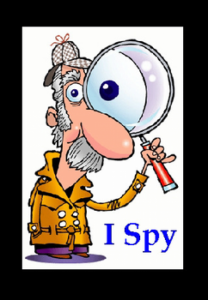Creating I Spy Videos
Young children love to play games. For example, currently, my five-year-old daughter is in love with the game Chutes and Ladders, a board game that has the players climbing up ladders and sliding down chutes in an attempt to be the first player to reach the top 100th square. She not only enjoys the competition, she likes that the game has rules, a spinner and the surprises that await when the game pieces are moved the number of spaces indicated on the spinner. Besides the enjoyment of simply playing the game, she is actually practicing her early math skills such as counting and one to one correspondence. As early childhood educators, we are always looking for ways to harness the playful nature of children to make learning fun and to practice or introduce new skills and concepts. One fun way to do this is to use the I Spy books in your classrooms. 
The I Spy books by Jean Marzollo and Walter Wick as well as the Can You See What I See books by Wick are wonderful books that invite children on an exciting adventure to use their developing observation skills to look carefully for strategically placed objects in visually appealing scenic photographs.
Helping children know as much about the process of observation and creating searching games will not only make the experience more fun, but it will also provide them with more information for how to best approach the activity. Take a look at this video of a walk through Walter Wick’s studio. The process he uses to build his scenes for his photographs is fascinating.
At Catherine Cook School in Chicago, we have observed even our learners as young as three years old enjoying the experience of creating their own I Spy-like scenes. There are many ways to approach the creation of these scenes, and embracing a mathematical focus can be extremely exciting for children, as well as informative for parents and teachers. Consider these steps to create a video:
Step 1 (Parent/teacher):
Identify the mathematical skills or concepts you hope to observe and/or invite the children to explore.
For example:
- The I Spy video will focus on basic shapes: “Find 3 squares, find 2 circles, find 4 rectangles.”
- The I Spy video will focus on number identification: “Find 3 number 2’s, find 1 number 10, find 2 number 8’s”
- The I Spy video will focus on quantities: “Find 3 pieces chickens, find 6 kittens, find 8 light bulbs”
Challenge: Depending on the abilities of the children in your care or class, consider combining skills and concepts.
For example: The I Spy video will focus on quantities AND shapes: “Find 3 red squares, find 2 yellow circles, find 4 blue rectangles.”
Step 2 (Parent/teacher and child(ren)):
Make/write a visual list of the items to be found in the I Spy scene.
Step 3
Invite the child(ren) to search for those necessary items around the house or classroom as well as other items to assemble and create the scene.
Step 4
After carefully arranging the items together on a table or tray, grab your tablet and a take clear photograph of the scene.
Step 5
Install the application, Draw and Tell by Duck Duck Moose on your tablet.
Take a tour of the Draw and tell app by Duck Duck Moose here.
Step 6
Launch the application and use the photograph taken of the scene from the Camera Roll/Photographs and use it as the background.
Step 7
Use the recording feature of the Draw and Tell application to tell and point out where the items are in the scene.
Step 8
Save your video to the Camera Roll/Photographs and share with friends, family, teachers, or whomever you like via email or social media. When sharing the video via email or social media, be sure to include the list of items to find in the scene!
Enjoy creating your own I Spy videos!
this is a great idea that i will use thank you
Great idea my kids will love this.